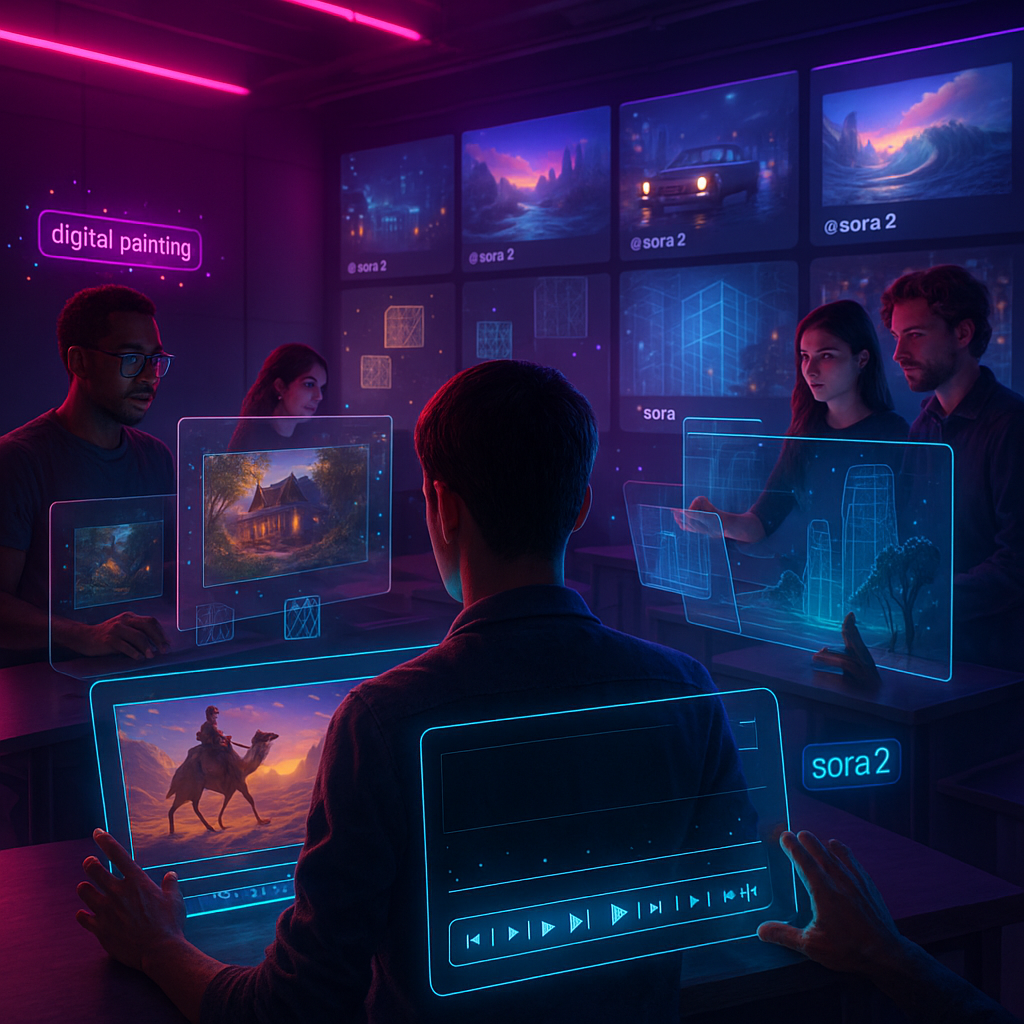Key Takeaways
-
Sora 2 merges generative AI and social sharing: The new platform allows users to create visual stories with AI and instantly publish or share them, blurring traditional lines between author, audience, and algorithm.
-
OpenAI signals a cultural shift, not just technological: Sora 2’s launch marks OpenAI’s clear ambition to shape not only how media is made, but also how digital communities are built around algorithmic creativity.
-
Broader reach beyond AI enthusiasts: With a simplified interface and integrated sharing tools, Sora 2 is designed for creators, casual users, and thinkers alike, diversifying participation in AI-driven artistic experiments.
-
Immediate ethical and philosophical questions arise: The platform’s seamless blend of authentic and synthetic content reignites debates about authorship, creative agency, and the hidden biases of generative AI.
-
OpenAI teases upcoming features and community tools: Scheduled updates promise collaborative options and transparency measures, inviting users to help co-author the norms of this new creative frontier.
Introduction
OpenAI has introduced Sora 2 at its headquarters, unveiling a platform where generative AI converges with instant social sharing to reshape the crafting and circulation of visual narratives. By lowering entry barriers and blurring authorship lines, Sora 2 signals a cultural shift that thrusts creativity, identity, and agency into focus. This marks a new frontier in the ongoing interplay with algorithmic imagination.
The Evolution of Sora
OpenAI’s Sora 2 represents a significant departure from traditional AI image generation, introducing social features that transform solitary creation into collaborative storytelling. The platform builds on its predecessor’s text-to-video capabilities with new tools for community interaction and creative exchange.
Within integrated creative spaces, users can now share prompts and resulting creations. These “collaborative canvases” invite multiple participants to build upon each other’s work, generating evolving visual narratives.
Sora 2 maintains detailed provenance tracking, documenting how images and videos change through various iterations and contributions. This approach addresses concerns about attribution in AI-generated art and fosters transparency in the creative process.
Stay Sharp. Stay Ahead.
Join our Telegram Channel for exclusive content, real insights,
engage with us and other members and get access to
insider updates, early news and top insights.
 Join the Channel
Join the Channel
Technical Innovations
At the core of Sora 2 is an enhanced comprehension of spatial and temporal relationships. The system demonstrates improved coherence across extended narratives. It maintains consistent characters and settings in longer sequences.
The platform introduces “context-aware generation,” enabling it to interpret elements from reference images and previous creations more effectively. This leads to more nuanced and intentional creative outcomes.
Advancements in natural language processing help Sora 2 better understand subtle creative directions. It responds with greater accuracy to complex artistic ideas and emotional nuance in prompts.
Creative Community Impact
Artists and filmmakers testing Sora 2 report discovering unexpected creative opportunities. Documentary filmmaker Sarah Chen observes the platform opens new ways of visualizing concepts that would be impractical or impossible with traditional methods.
However, some creators express concern about the implications for established artistic practices. Visual artist Marcus Rodriguez states that careful thought is needed about how AI tools should complement rather than replace human creativity.
Digital arts communities are already exploring innovative formats enabled by the platform. Online creative collectives have begun organizing “visual jam sessions,” where members build upon each other’s AI-generated works in real time.
Philosophical Implications
The arrival of Sora 2 provokes questions about creativity in an AI-enabled world. The platform’s collaborative features challenge traditional views of individual authorship and artistic ownership.
Digital anthropologist Dr. Elena Kovacs notes that such tools are reshaping understandings of creative agency, blurring distinctions between human and machine contributions.
Sora 2’s provenance system, combined with its emphasis on remixing and iteration, suggests new models for creative attribution in the digital age. This approach may offer solutions to persistent debates about ownership and credit in collaborative digital art.
Ethical Considerations
Privacy advocates highlight the need for clear guidelines regarding the use of personal imagery and likeness rights in Sora 2’s collaborative spaces. The platform’s content policies aim to balance creative freedom with responsible use.
Questions surrounding bias and representation in AI-generated content remain central to the debate. OpenAI has reported the implementation of safeguards to promote diversity and prevent harmful stereotypes.
Researchers emphasize the importance of retaining human agency in creative processes. Digital ethics expert Dr. James Morton argues that these tools should augment, not automate, human creativity.
Cultural Significance
Sora 2 reflects a broader shift toward collective creativity in digital arenas. Its social features acknowledge that meaning and value in contemporary art frequently arise through community interaction and interpretation.
Cultural theorists suggest this marks a transition from individual genius to collaborative innovation as the prevailing creative paradigm. This shift parallels wider trends in digital culture toward shared experience and collective meaning-making.
Museums and cultural institutions are exploring ways to integrate AI-collaborative art into their programs, recognizing its importance in current creative practice.
Conclusion
Sora 2 stands at the juncture where digital creativity becomes fundamentally collective, weaving together technological advancement and social collaboration. Its ongoing evolution encourages reflection on the meaning of authorship, authenticity, and agency in a networked era. What to watch: responses from creative communities and updates to OpenAI’s provenance and content policies as new collaborative formats develop.
Stay Sharp. Stay Ahead.
Join our Telegram Channel for exclusive content, real insights,
engage with us and other members and get access to
insider updates, early news and top insights.
 Join the Channel
Join the Channel
digital selfhood
authorship and creativity
AI aesthetics
fair, inclusive datasets
machine consciousness





Leave a Reply